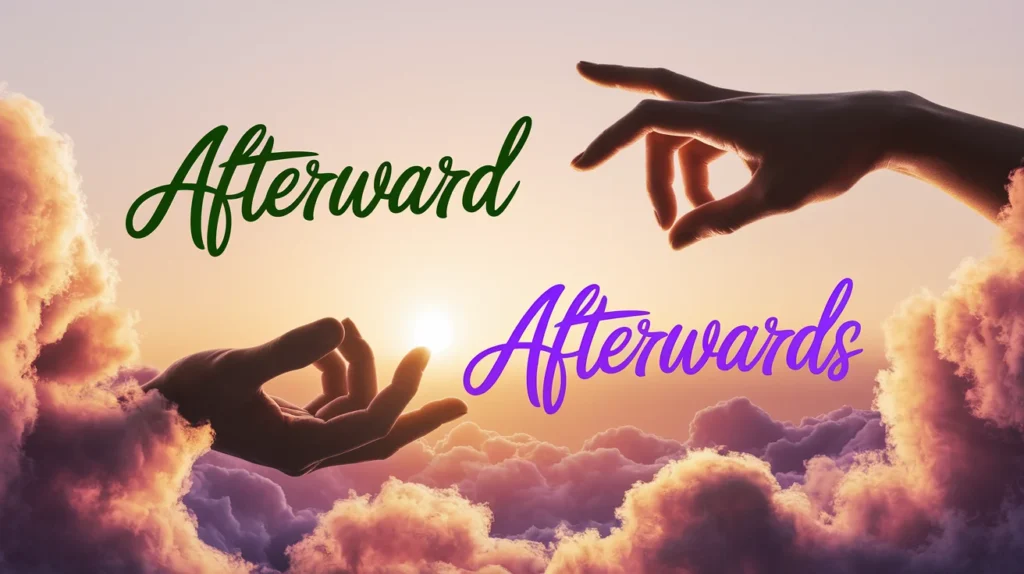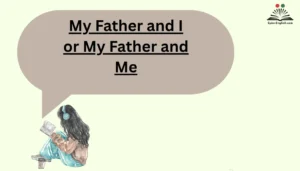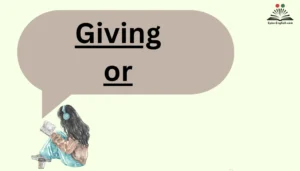The debate between “afterward” vs “afterwards” has been a long-standing one in the English language, creating confusion among writers, students, and even seasoned authors. If you’ve ever found yourself questioning which word to use, you’re not alone. This seemingly minor difference between two words that carry the same meaning can be a source of frustration for many.
In this post, we’ll dive deep into the differences between “afterward” vs “afterwards,” examining their meanings, usage in different contexts, and their history. While these words are often used interchangeably, their origins and regional preferences can influence which form you choose. Understanding when and why you should use one over the other will not only clarify your writing but also help you communicate more effectively, whether you’re in the United States, the United Kingdom, or beyond.
By the end of this article, you’ll have a clear grasp of how to use “afterward” and “afterwards” correctly, along with examples, synonyms, and tips to help you master these two terms. Let’s explore the nuances of this common English dilemma!
Why Is There Confusion Between “Afterward” and “Afterwards”?
The confusion between “afterward” vs “afterwards” largely stems from the differences in spelling preferences between British and American English. Both words mean the same thing: at a later time or subsequent to something. However, there are subtle differences in usage that are influenced by regional conventions, historical changes, and the evolution of the English language.
- British Influence: British English tends to prefer words that end with an ‘s’ (like “afterwards”), while American English often drops the ‘s’ (as in “afterward”). This difference can be traced back to the early 19th century when American lexicographer Noah Webster simplified many English words to create a more “streamlined” version of the language.
- American Adaptation: In the United States, “afterward” is the preferred form in most situations, especially in formal writing. This preference is likely due to Webster’s reforms, which favored eliminating redundant letters.
What Do “Afterward” and “Afterwards” Actually Mean?
Both “afterward” and “afterwards” are adverbs used to indicate that something happens later or subsequent to an event. Despite the different spellings, the core meaning of both words is the same: “at a later time” or “subsequently.”
Core Definition of “Afterward”
- Meaning: Used to indicate something happening at a later time.
- Example: “We went to dinner, and afterward, we saw a movie.”
Core Definition of “Afterwards”
- Meaning: This is simply the pluralized form of “afterward,” carrying the same meaning.
- Example: “We went to dinner, and afterwards, we went to a bar.”
Both words convey the same idea—something happens later, following a previous event—but the distinction lies in the style of the writing and regional preferences.
“Afterward” vs “Afterwards”: Grammar, Style, and Usage Differences
The primary difference between “afterward” and “afterwards” comes down to grammar rules and stylistic preferences that vary by region.
Formality and Style
- “Afterward”: While neither word is particularly formal, “afterward” is often used in more formal writing, especially in American English. Many academic journals, articles, and business documents in the U.S. favor this version.
- “Afterwards”: This form is generally more common in British English and often used in informal contexts. It may appear in more narrative writing, such as novels, or when speakers are using a conversational tone.
Usage Frequency
- American English: “Afterward” is the preferred form in the U.S., used more frequently in both formal and informal contexts.
- British English: “Afterwards” is the favored form in the UK and other parts of the Commonwealth, particularly in informal communication and literature.
British English vs American English: The Real Reason Behind the Spelling Shift
The reason for the difference between “afterward” and “afterwards” lies in the historical evolution of the English language, especially the shifts introduced by Noah Webster, an influential figure in American lexicography. His desire to simplify spelling in American English led to the dropping of many unnecessary letters, including the ‘s’ at the end of certain adverbs.
Why British English Tends to Add ‘-s’ to Some Adverbs
In the UK, British English kept many of the traditional spellings, including adding an “s” at the end of certain adverbs, such as:
- Afterwards
- Towards
- Backwards
- Forwards
These forms were retained from Middle English and continue to be used in everyday language, even in formal contexts.
Why American English Drops the ‘-s’
Webster’s reforms aimed to simplify the language by removing superfluous letters. As part of this simplification, American English dropped the ‘s’ from words like “afterwards” (leaving “afterward”), “towards” (becoming “toward”), and “forwards” (becoming “forward”). This made spelling more straightforward, and the changes stuck, especially in the U.S.
Which Should You Use: “Afterward” or “Afterwards”?
The choice between “afterward” and “afterwards” often comes down to regional preference and writing style. Here’s a breakdown of when to use each:
- Use “afterward” if you are writing in American English, especially in formal or academic contexts.
- Use “afterwards” if you are writing in British English or when the sentence is informal or conversational.
- Stick with one form throughout a document to maintain consistency.
- Neutral option: If you are writing for a global audience, it’s often safest to use “afterward,” as it is the preferred term in international business and academia.
Examples in Context: “Afterward” vs “Afterwards” in Real Sentences
Afterward Examples
- “We had a long meeting, and afterward, we went for coffee.”
- “She finished her homework, and afterward, she watched a movie.”
- “After the conference, we gathered for a networking event. Afterward, the speakers had a Q&A session.”
Afterwards Examples
- “They attended the gala, and afterwards, they went for drinks.”
- “He graduated with honors, and afterwards, he started his new job.”
- “After the show ended, the audience left, and afterwards, the crew cleaned up.”
Common Synonyms and Similar Expressions
While “afterward” and “afterwards” are widely used, there are several synonyms and alternative phrases that can express the same idea of “later” or “subsequent.”
Universal Synonyms for Both Words
- Later
- Subsequently
- Then
- In due course
- Next
- Following that
Specific Contextual Alternatives
- For timelines: “In the aftermath,” “at a later stage”
- For cause/effect: “As a result,” “thereafter”
- For narrative: “In the end,” “eventually,” “finally”
Etymology and Origins of “Afterward” and “Afterwards”
Both “afterward” and “afterwards” derive from Old English “æfter” (meaning after) combined with the suffix “-ward” or “-wards”, which indicates direction or position. The use of the suffix “-s” is a later development in British English.
When Did the ‘-s’ Ending Enter the Language?
The ‘-s’ suffix was introduced to English words during the Middle English period, around the 14th century. Words like “towards,” “backwards,” and “afterwards” were commonly used with this ending in literary texts, and the pattern carried on through modern English.
When Did “Afterward” and “Afterwards” Diverge?
The divergence between the two forms became more pronounced in the 19th century, particularly in the United States after the publication of Noah Webster’s dictionary. His spelling reforms contributed to the simplification of many words, dropping the ‘s’ in “afterwards” to create “afterward.”
Grammar and Syntax Tips: When & How to Use Them Correctly
Position in a Sentence
Both “afterward” and “afterwards” are adverbs, meaning they can appear in different positions within a sentence:
- Beginning: “Afterward, we went home.”
- Middle: “We went to dinner afterward.”
- End: “We went to dinner, and afterward, we saw a movie.”
Punctuation Rules
- When “afterward” or “afterwards” appears at the beginning of a sentence, use a comma to separate it from the rest of the sentence.
- When it appears at the end, a comma before it is usually unnecessary.
Common Mistakes
- Misplacing as a noun: Avoid using “afterward” or “afterwards” as nouns (“The afterward of the event”).
- Confusing them with “after”: “Afterward” and “afterwards” are not synonymous with “after” (which is a preposition). Instead, they should be used to describe something that happens later in time.
Regional Usage Trends: Which Countries Prefer Which Form?
As previously mentioned, the usage of “afterward” vs “afterwards” is largely influenced by geographic location.
| Region | Preferred Form | Notes |
| United States | Afterward | Predominantly used in formal and informal contexts |
| United Kingdom | Afterwards | Commonly used in both casual and formal contexts |
| Canada | Both forms | Often depends on the writer’s preference or style guide |
| Australia | Both forms | “Afterwards” is often used in casual writing |
“Afterward” and “Afterwards” in Pop Culture and Media
Both words appear in books, movies, and even speeches, often shaping the tone of the narrative. For example, in classic British novels, “afterwards” is commonly used in the descriptive and narrative style. In American films and academic articles, “afterward” tends to be favored, aligning with U.S. language conventions.
Final Thoughts: Which One Should You Choose?
The choice between “afterward” and “afterwards” is not as complicated as it seems. Both words are correct and convey the same meaning. Your choice ultimately depends on your location, the audience, and the context.
- If you’re writing for an American audience, “afterward” is the safe bet.
- For a British audience, or in informal contexts, “afterwards” is often the better choice.
Whichever you choose, the key is consistency. Stick to one form throughout your writing, and you’ll avoid confusion.
FAQs: Afterward vs Afterwards
Is “afterward” outdated or modern?
No, “afterward” is not outdated. It’s widely used in American English.
Can I use both interchangeably in a single document?
It’s better to choose one form and use it consistently throughout your work.
Is “afterwards” considered more polite/formal in the UK?
Not necessarily. “Afterwards” is just more common in British English, but it’s neither particularly formal nor casual.
Is one more commonly taught in schools?
“Afterward” is taught more frequently in American schools, while British schools tend to focus on “afterwards.”




